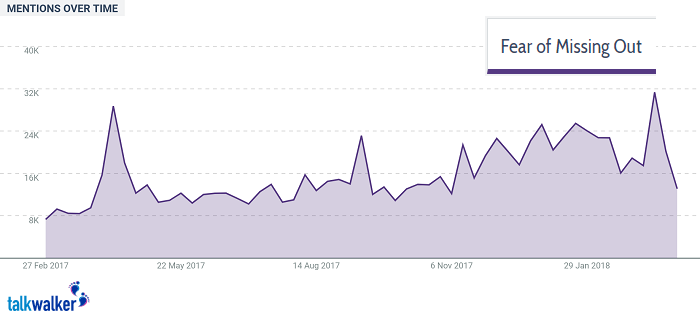Why use scarcity marketing?
When in a saturated market, you need a hook that makes your business stand out from the competition.
Lower prices could help, but imagine a tactic that could encourage organic conversation about your brand, and actually help you increase the value of your product.
That’s scarcity marketing.
And you’ll find it used across numerous industries.
It’s especially common in retail, as companies use several exclusivity techniques, like limited time sales, to encourage consumers further along the buying cycle.
It’s also common in the tech industry, whether for promoting apps or devices. Apple is a great example, as people will queue overnight to be one of the first to own an iPhone X (and spend nearly $1,000 for the privilege).
Scarcity marketing is everywhere. But it’s also a risky tactic.
With limited items and restricted membership, means some of your consumers will miss out, leading to frustration, disappointment, and anger. You need to use social media listening to make sure your strategy doesn’t backfire.
But why exactly does it work so well?
Scarcity marketing is the fear of missing out
The reason why scarcity marketing tactics are so effective is due to our fear of missing out, or FOMO (fear of missing out). It’s driven by the explosive growth of social networking that gives us a greater opportunity to connect with people around the world. But that increased reliance on the internet encourages people to feel more anxious about missing something important.
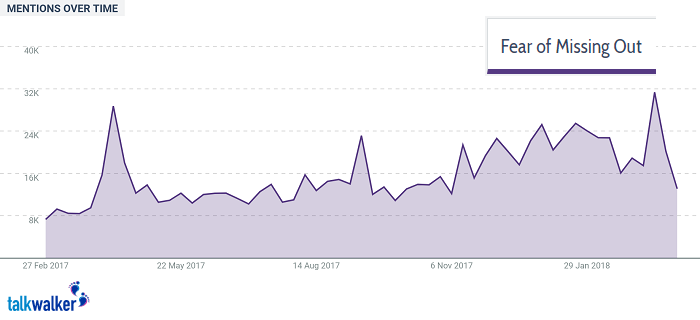
Mentions of FOMO have increased over the last 13 months, with a total of nearly 1 million mentions.
Brands can make the most of this in their sales and marketing strategy, by the scarcity principle.
What is the scarcity principle?
It’s simple. Consumers place a higher value on goods that are scarce. Or even, just perceived to be scarce. So, by decreasing the availability of your product or service, while still maintaining the demand, will make your product more scarce. Meaning you can charge a premium price.
That’s why scarcity marketing is so effective. You’re decreasing supply, tipping the equilibrium in your favor.
Being an exclusive brand
In What Exclusivity Can Do for Your Business Marketing, Rachel Winsted explains how you can use exclusivity as your entire marketing strategy. This relies less on traditional marketing techniques, and more on making your brand appear unique.
This boutique style can be more cost effective, as you don’t need to advertise to everyone. In fact, it benefits from fewer people knowing about the brand. That way, new consumers get an extra thrill from discovering you and will sell you to their friends, if only to show off what they’ve discovered.
The three things for making this strategy work are:
-
Networking
With fewer marketing channels available, you want more face to face engagement. It’s a more personal way to promote. Therefore, more exclusive.
-
A simpler online presence
You want to create engaging social media content, not promotional sales posts. Give clients the opportunity to find out more about you on their own accord.
-
An amazing customer experience
This is essential. There’s no point in being exclusionary if what you offer isn’t. It’s easy for exclusivity to go wrong if there’s nothing unique about the brand (though we’ll cover that later).
Luxury, scarcity, & social
The luxury industry is often seen as an elusive market. But exclusivity doesn’t mean being aloof. Social media engagement is still critical for luxury brands (in fact, any brands), and actually has a bigger impact for those using scarcity marketing.
According to digital marketing expert, Christopher Parr, affluent consumers are active and vocal, so are more likely to spread brand messages than others. Luxury brands often having around 20 times the likes of equivalent brands on Facebook.
“As a luxury brand, you need to engage your affluent consumers. Invite them in, inspire them – and in-turn, convert them into brand-advocates.”
Exclusive brands still need to engage their audience online and demonstrate value to that audience. Only then, will those vocal consumers actively promote you.
Don’t forget, social media conversations happen whether you’re part of them or not, with around two-thirds of your luxury audience creating user-generated content on a regular basis. Make sure you’re part of those conversations, no matter how preferential you are.
DKNY still engages their consumers online, ensuring they feel a part of the ‘privileged’ community.
Discover how luxury brands engage on social
How to define exclusivity in other ways
If a complete scarcity strategy isn’t for you, there are other ways to use preferential tactics in marketing. These include:
Limited quantities
This is a technique often used by retailers to help nudge consumers down the buying funnel. By displaying how much product is left in stock, you’re creating a sense of urgency. That means, if your consumer is in the consideration stage, they may buy sooner if they think they could miss out later along the line.
Travel booking websites often do this, displaying how many rooms remain in your results. It’s also a technique Amazon uses.
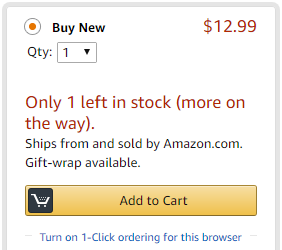
Knowing there’s only one book left encourages Amazon’s consumers to buy now,
rather than wait until next week.
Unavailability
This takes the process one step further. If you’re unable to supply an item immediately, don’t take it down from your store.
Display it as out of stock, to tell your consumers that…
- The item is popular.
- They haven’t got it yet.
Add in the option for someone to leave an email address, and you’ll get data collection opportunities, with a confirmed list of people with buyer’s intent.
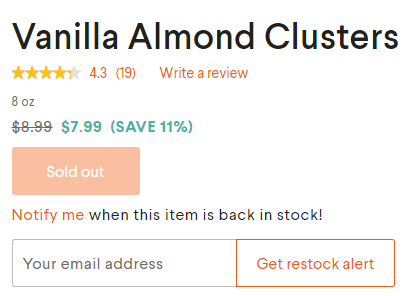
With many short shelf life products, NatureBox maintains consumer engagement by offering restock alerts for every item.
Pre-orders
If a limited stock is so effective for increasing demand after you’ve started selling a product, then it must have an impact before the product even comes into stock, right?
That’s where pre-orders come in. Not only do you drive consumer interest in your product, but also encourage increased sales from dedicated consumers that have to have the latest product (FOMO again).
This could either incorporate a pre-order list (more data capture) or a countdown to release date. This generates more buzz and makes your product launch more of a momentous event.
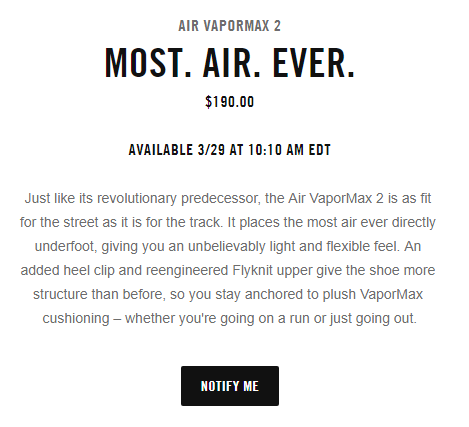
Nike offers a calendar of upcoming releases to entice consumer interest.
Nike is also masterful at handling the limited edition market (see below). By regularly creating limited supplies of select shoes, they create almost a cult following and practically guarantee a sell-out.
Not only does this give the brand extra buzz for the release, but also drives the demand for future releases (“I didn’t get one last time, so I must get one this time!”) The strong resale market this generates, also encourages more people to want to purchase the item.
These are no longer trainers. These are a must-have investment.
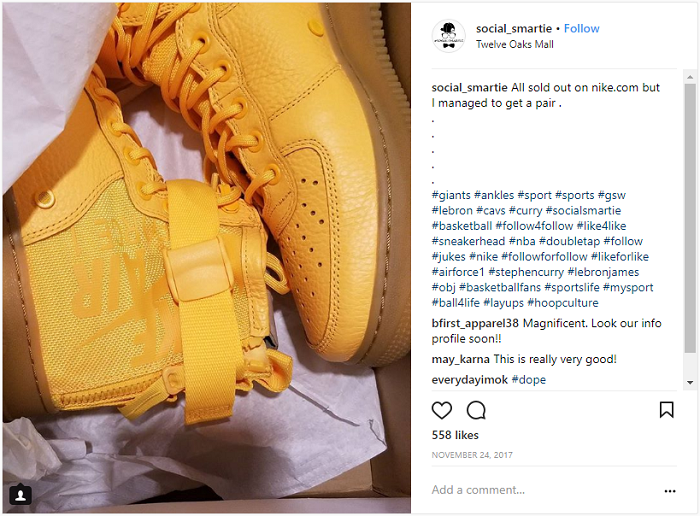
Being ‘Sold out’ is what makes these sneakers so valuable.
Limited editions
How do you ensure exclusivity when selling a product?
Limit that product.
By limiting the production of any product, you ensure scarcity and drive more momentum for your product launch. Whether that’s an event-only item (to encourage attendance), store limited editions (to encourage consumers to buy from a particular store), or short supply versions of a mainstream brand (to generate buzz about a new release).
This is common in the games industry and for digital products, to incentivize people to buy a physical copy of a game, instead of an instant download.
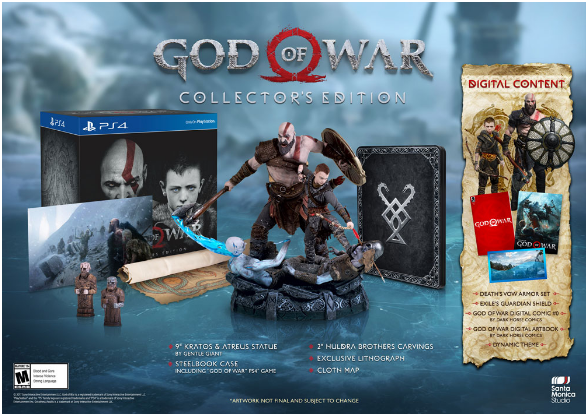
You could buy the instant download of a game, but then you’d miss out on loads of extras.
Exclusive content
The limited items needn’t be physical. You can add unique content to any website, by gating. The fact that the information isn’t available to anyone, adds extra value to it, and again, gives you data capture opportunities.
Not all of Talkwalker’s content is available instantly on our blog.
We also have exclusive gated content.
Limited-time offers
Limited-time events are a slight variation on this, and one of the most common attempts at exclusivity. These can range from seasonal sale events to one-day sales. Amazon has mastered this tactic, offering Deals of the Day throughout the year, with a particular focus on Black Friday, and Prime Day.
Consumers have to act fast or miss out.
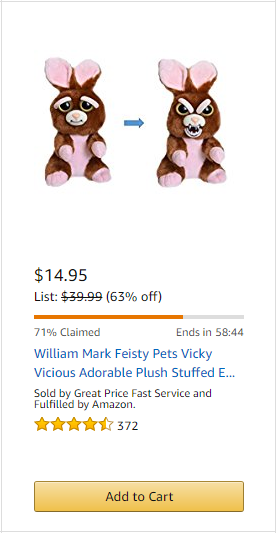
Not only are Amazon’s Deals of the Day time-limited, they’ve limited number too.
With a countdown timer showing the product remaining.
Crowdsourcing
What happens if you offer a limited product, for a limited time, through a pre-registration, and made available before the rest of the market?
You’d expect pretty spectacular results.
And that’s what crowdsourcing gives businesses.
No wonder mentions of the biggest crowdsourcing company, Kickstarter, are at a 13-month high.
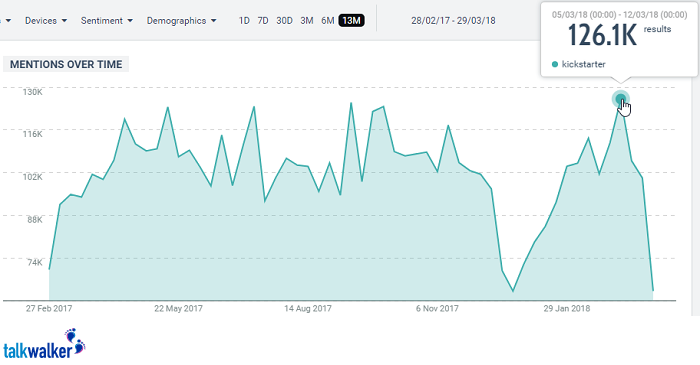
Pebble demonstrated how powerful these exclusivity marketing innovations can be, with three record-breaking Kickstarter campaigns, including the largest of all time for the Pebble Time. A phenomenal result for a company that initially struggled to raise finance through traditional methods.
Invite only
What makes the biggest social occasions so special?
It’s not the glitz, the glamor, or the guests. It’s the fact you got an invite.
Not only are you good enough to be on the guest list, but it also means you’re better than the people that aren’t.
And that’s the thinking behind invite-only marketing.
The limited availability increases the users desire to join, and motivates them to engage with the product more once invited (after all, it’s a privilege to be on the guest list. You may as well make the most of the party).
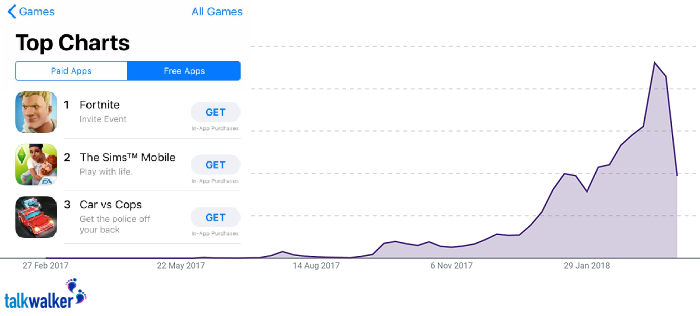
Despite being invite only, Fornite is now the No.1 game on the Apple App Store,
and receives up to 2.8M mentions per day.
Invite only also comes with added technical benefits. With a more controlled level of joiners, you can manage the upscale of supply or technical support as needed. Therefore, minimizing the impact technical issues or supply delays have on your consumers.
Curated membership
A similar technique to build exclusivity is to have curated membership. Whether that’s to a Facebook group, or to your entire site, is up to you, but you’ll still give your members the feeling that they’re special. And entice non-members to join.
It’ll also mean you’ll have a more engaged audience, as you can ensure members qualify for your product and keep out spammers.
Good scarcity marketing: The Boring Company
We can’t cover the power of exclusivity without mentioning Elon Musk.
He’s used a pre-order system for Tesla to launch the Tesla 3 car (with over half a million units reserved by people who are desperate to drive one first).
Musk’s Boring Company also knows the benefits of scarcity. They’ve released various objects, often without a defining factor (like their Boring caps) or even without a practical use (I'm looking at you, flamethrowers). Yet, due to their limited nature, they sold exceedingly well.
They certainly have a thorough understanding of how to promote products and encourage consumers to buy pretty much anything. Whether they can sell lumps of rocks just because of scarcity marketing will be their next true test.
Bad scarcity marketing: Tidal
One thing to remember is that scarcity marketing shouldn’t overshadow your product.
According to Corey Pembleton’s blog on Velvet Rope Marketing, before you look to scarcity marketing for success, you must first “start with a quality offer people can’t find anywhere else.”
That was Tidal’s problem.
As noted by Ramona Sukharj, Tidal’s biggest issue was that they don’t offer a clear customer value.
Launched in late 2014, they offer a subscription-based music streaming service, with 2 features:
-
Bespoke content.
-
Lossless, high-quality music and HD video.
It competes against brands such as Spotify, which offers a freemium service.
But with no consumer reviews or free trial, there was no clear differentiator for Tidal. They may claim that they’re exclusive, but they need to back that up.
There’s also an issue with the quality benefit being a little too limited. To enjoy it in full, users have to invest in higher end audio equipment, limiting the potential audience.
As of 2017, Tidal claimed to have around 3 million subscribers (although that number may have been inflated), while Spotify had around 50 million paying subscribers in the same period.
Pass it on
There we have it. The ins and outs of scarcity marketing, and some of the pitfalls to avoid if it’s a marketing strategy you want to try. Feel free to share.
If you want to know what’s trending (essential if you don’t want your brand to be too exclusive), you can request a free demo of Quick Search below.

